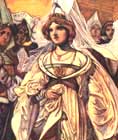
Cinderella:
345 Variants
by Marian
Roalfe Cox
SurLaLune's
Cinderella Area
SurLaLune Fairy Tales Main Page
124
Vuletic-Vukasovic, Vid. Unpublished Story from Spalatro, Dalmatia, contributed by. (Narrated and written down in Italian by Signorina Alodia Riboli.)
"LA CUZZA TZENERE."1
ABSTRACT
Mother and three daughters are spinning; whosoever drops spindle thrice, to be killed and eaten by others--Slaying of mother--Bones collected by heroine and buried under hearth-- Ill-treated heroine (by elder sisters)--Hearth abode--Tasks, grain-sorting -- Magic aid from bones (1) birds, (2) chickens, (3) mice---Magic dresses--Meeting-place (ball)--Threefold flight--Pursuers detained with scattered gold--Pitch-trap--Lost shoe--Shoe marriage test--Happy marriage.
TABULATION
(1) Mother and three daughters work for their living in the capital. In year of great scarcity they are unable to earn enough to support them, and at length determine that, as they sit together spinning, the one who drops her spindle three times shall be killed and eaten by the others. Mother drops hers thrice, and elder sisters bid heroine take hatchet and slay her. She refuses to do so, urging that she shall not eat of mother's flesh.-- (2) One of the sisters goes for hatchet, and, meanwhile, mother gives heroine a wand, bidding her collect her bones when sisters shall have killed and eaten her, put them away, and whenever in need or in danger to strike them with wand, and she will obtain anything she requires. Mother is slain, and part of her body is cooked for food. Elder sisters begin to eat, picking the bones, and throwing them under the table, where heroine crouches in order to collect them. After some days the whole body is devoured, and heroine has collected all the bones in a handkerchief and put them under the hearth. She stoops over them continually to guard them, and is therefore nicknamed, "Cuzza tzenere".-- (3) It is carnival time, and elder sisters are going to ball. They get ready, and, before leaving, give heroine three measures (each of 11.89 litres) of millet to cleanse by their return, or they will beat her. Heroine, at first, begins to weep, but, bethinking her of mother's promise, she strikes with wand the handkerchief containing bones, and hears voice asking what it is she wants. Heroine explains, and sees appear a crowd of birds, which undertake to perform task, while she goes where she will. She washes and combs herself, then uses wand again, and asks for a dress of fine fabric, ornamented with suns. She gets dress and shoes to match, and iii the court yard finds equipage with grandly dressed coachman. She drives to ball king's son deserts all other girls to dance with her alone, he seeks to know who she is and whence she comes, but she will reveal nothing. Before the ball is over she leaves in her coach, strikes bones with wand to make dress and equipage disappear, dons old gown, and sits by the hearth. Sisters return, ask if she has done task, then tell her of beautiful foreigner. Heroine sighs, and murmurs, "Suppose it was I!" and sisters say, "Get away you ugly Cuzza tzenere!"-- (4) Next day, before going to ball, Sisters give her four measures of corn to cleanse by their return. Heroine weeps at ill-treatment, and again seeks aid of bones. A crowd of chickens appear to perform task, while she goes to ball in dress ornamented with moons. All marvel at her; king's son dances with her all the time, but tries in vain to discover who she is and whence she comes, he orders his servants to follow when she leaves, and find out about her; but she goes before ball is over, throws handful of gold to detain pursuers, and drives quickly home.-- (5) Third day sisters give her thirty pounds of wool to card during their absence. She applies to mother's bones for aid, and task is performed by a crowd of mice, whilst she goes to ball in dress covered with stars. King's son calls aside one of his servants, and bids him tar the door-post of the ball-room, so that when heroine leaves first, as before, one of her shoes at least will remain sticking to it. In this way heroine leaves left shoe behind, then gets into coach, and again throws money to those who would follow. Sisters return, and have same conversation with heroine.-- (6) Next morning proclamation is made that king's son will visit every family to try the shoe, promising to wed whomsoever it fits. All the houses are visited, but shoe fits nobody. King's son comes to house of three sisters, but heroine knows nothing of it. Sisters don their best clothes to appear before king's son. Shoe is too narrow for one, too short for the other. He asks if there are not other girls in the house, and, noting their confusion in replying, commands that any girl in the house be brought before him, no matter what she be.-- (7) Sisters take some of their own garments to heroine to make her presentable, but she spurns them, saying she has no need of their rags, having things of her own to dress in. She gets star-dress from mother's bones, and, with only one shoe on, appears before king, who recognises her the instant he sees her, fits the other shoe on her, and takes her to be his bride.
NOTES
1: A corruption of cuccia = canile, dog-kennel, and cenere. Tz is pronounced like the Slav. c or the Ital. soft z. See note 66.
Note 66
(P. 416.) I am indebted to the kindness of Sig. Vid Vuletic-Vukasovic, of Curzola, Dalmatia, for some interesting "Observations", which I here translate, on the story of "Pepeljuga" (Cinderella):--
No story is so widely diffused amongst the Southern Slavs as that of Cinderella. In every variety of circumstance she is an unfortunate orphan whose mother has died a natural death, or has been the victim of sacrifice. Even the smallest village has more than one variant of the story, which may be referred to one of two distinct types; the first derived from an Italian collection, Nuovo libro delle fateA; the second taken from the stories related by the Serbs. On these two prototypes almost all the other versions are based. In Dalmatia all variants of Cinderella (called ' Cuzza-tzenere' in Spalatro, Sebenico, and the island of BrazzaB) have been somewhat influenced by the Italian prototype, while the second prototype has coloured the remaining variants of the story, found on the peninsula of Balcanica, and, united with the first, has produced a commingled version found throughout Dalmatia and the sea-board of Croatia. In Dalmatia it is always narrated in Slav, as also in Bosnia, Herzegovina, and in other districts of the Balkans. This story has entered so realistically into the national life that the term 'Pepeljuga' is commonly applied to any poor girl who is persecuted or neglected.
"In the mountains, where the people principally lead pastoral lives, the mother [in the story] gets transformed into a heifer; whereas on the coast the mother dies a natural death, or is killed by the two elder daughters, and mourned by the youngest. In the mountains, the heifer is a sort of tutelary genius to the poor innocent girl, and when it is slain, 'she who loved it in life' (this is the customary phrase with the Slays), 'loves it still when dead'. Accordingly, in obedience to the injunction, she collects the bones and religiously buries them in a heap. It is well known that the Southern Slavs bury their dead under enormous monuments called Stecci. These are full of symbolical signs and other data drawn from the life of the deceased. More than three hundred thousand similar monuments have been enumerated in Bosnia, Herzegovina, Upper Dalmatia, and ancient Serbia, etc.; and during the last ten years the present writer has been at pains to illustrate them with their respective 'Ancient-Bosnian Epitaphs' in the archaeological journals of Agram, Sarajevo, and Belgrade.
"In Dalmatia, also, the dead mother's bones are collected by the youngest daughter and deposited in a tomb under the shadow of some tree, such as a walnut, a hazel, a pomegranate, or an apple-tree, etc. In the mountains the girl receives no visitation; while in Dalmatia her dead mother appears to her in the form of a fairy (ninfa), comforts her, and gives her a magic wand with which to strike the tomb, in order to obtain assistance when in trouble.
"In the mountains, the two doves appear and converse with the orphan. In Dalmatia she goes to the ball in a carriage, having obtained all she requires from the nut, apple, or other tree; in the mountains there simply appears a casket, in which she finds the several dresses. In the mountains the task is of two sorts: up to the time of the death of the heifer it consists in spinning, and afterwards in performing the most menial household duties, and in picking up millet or lentils; while in Dalmatia, in a large number of variants, the task consists solely in spinning, and is performed at a stroke of the magic wand. In Dalmatia, in the several variants, millet and lentils are mixed together, and, by means of the magic wand, are sorted by a number of birds and ants. In Dalmatia the girl escapes from the ball under the excuse of going to drink some water, or fasten her garters, or so on; while in the upper districts of the Balkans she escapes before the end of divine service, or before the fair is over--for in this region she goes either to church or to the fair.
"In Dalmatia there is not always a cruel stepmother, but there are invariably the two cruel sisters, more ugly than the youngest; while in the higher districts there is always a cruel stepmother with her one ugly daughter. In Dalmatia the enchantments are brought about by means of the magic wand, while in the mountains the girl simply prays; thus, in Dalmatia, either Spanish or Italian genius has had some influence on the popular tale.
"In Dalmatia it is always 'the king's son', in the mountains 'the emperor's son'. The king's son, in Dalmatia, smears the steps of the palace with tar, that the shoes may adhere to them; but in the mountainous districts the girl simply loses her shoe in escaping through the crowd. In both varieties of the story the father plays an insignificant role, and in Dalmatia next to none. In all districts the search is of a similar nature, but there is some variety as to the manner in which the heroine is discovered; for instance, in the mountains she is hidden by her stepmother under a trough and spied by a cock; in Dalmatia, in the garret or under the chimney. In every case she appears in the clothes she wore at the last church or ball, but without the corresponding shoe. When she is recognised she is married to the son of the king or emperor. There is, however, this difference: in Dalmatia the two ugly sisters often figure in the wedding procession, and are punished by the two doves, which peck out an eye of each.
"Finally, it should be remarked that the dresses are more magnificent in Dalmatia than in the mountains; for in Dalmatia the first dress is of silk, ornamented with birds; the second is of silver, ornamented with the fishes of the sea; the third is of gold, ornamented with sun, moon, and stars. In the mountainous districts the dress enters the casket at the simple word of command, and disappears; in Dalmatia it enters the nut, or apple, and vanishes by virtue of the magic wand.
"There are but few variants in Dalmatia in which the two elder sisters eat their mother's flesh (which incident is probably borrowed from the Spanish), and in one solitary version Cinderella is in the service of some Dominican friars, and being persecuted by them, escapes to a forest and transforms herself into a serpent; she is presently retransformed into a lovely maiden by a king's son who is out hunting, armed with a gun, and with whom she had formerly been in love."
A: Sig. Vid Vuletic-Vukasovic
has kindly furnished me with a transcription of the version of "La
Cenerentola", found in the above-named collection, but I have not
reproduced it, as it differs in no respect whatsoever from Grimm's "Aschenputtel".
Return to place in note.
B:In Bosnia, Herzegovina, and
Servia she is called exclusively "Pepeljuga"; in Lika, Croatia,
"Pepeljavica"; and in Bol (Is. of Brazza), "Pepeljuznica".
Return to place in note.
Cox, Marian Roalfe. Cinderella: Three Hundred and Forty-five Variants of Cinderella, Catskin, and Cap O' Rushes, abstracted and tabulated. London: David Nutt for the Folklore Society, 1893.
While the original text of this book is out of copyright, the special formatting and compilation available on SurLaLune Fairy Tales is copyrighted. Be aware that while the original content has been honored, page numbering, footnote numbering, redesigned charts, links, and other aspects are unique to this site's version of the text. Use at your own risk. For private and fair use educational purposes only.
©Heidi
Anne Heiner, SurLaLune Fairy Tales
E-mail: surlalune@aol.com
Page last updated February 1, 2006
www.surlalunefairytales.com










